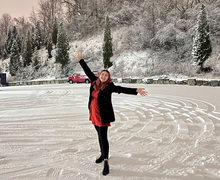Salt, heated sidewalks clear ice on campus
Syracuse isn’t called the Salt City for nothing.
With the Syracuse University campus so susceptible to snow, SU uses an average of 3,000 tons of salt every winter, said Rich Stach, SU grounds department manager.
“The way the winter’s going right now, it looks like there’s going to be a persistent snowfall. We’ll probably use around 2,000 tons this semester,” Stach said.
This could mean bad news for the environment, said Terry Ettinger, greenhouse manager for the State University of New York College of Environmental Science and Forestry.
“If you have a lot of salt in the soil, that salt can pull water out of the roots and back out into the soil, causing a drought response in the plant,” he said. “Take a look at the resources committed to repairing the damage along the sidewalks and the Quad every spring. That’s from salt and the plowing trucks driving over them every winter.”
Along with affecting plant life, salt can increase salinity in surrounding lakes, disrupt aquatic life and corrode infrastructure, Ettinger said. The Environmental Protection Agency estimates $750 in damage to concrete, bridges and vehicles for every ton of road salt.
With these negative effects in mind, the university has considered alternative solutions, such as installing heated sidewalks, said Rex Giardine, assistant director for capital projects at SU.
Currently, only a small portion of the campus, including the entrance outside Archbold Gymnasium, Shaw Hall’s ramp and the sidewalks between Archbold and the Physics Building, uses this snow-melting system, he said.
“It’s an option we wanted to use to make maintenance easier,” Giardine said. “They’ve been very successful in the last three years and function 24/7 as needed. You get a clean and dry sidewalk and no need for salt.”
ESF’s campus also uses heated sidewalks between its quad and Moon Library, Ettinger said.
Some students prefer heated sidewalks to the use of salt to melt ice, both for its self-sufficiency and cleanliness.
“The heated sidewalks are better because it gets rid of the problem to begin with. I have hardwood floors and I track it (salt) in, and we have to clean our floors all the time,” said Jana Goldenberg, a sophomore chemistry and forensics major. “We definitely wouldn’t have been sliding all over the place on Monday if we had heated sidewalks across campus.”
Giardine said the university would consider expansion if other construction work made an opportunity available. The expansion would be targeted toward building entrances and locations where salt’s negative effects have the strongest consequence.
“We originally put it outside of Archbold because there were complaints about salt ruining the exercise equipment inside,” Giardine explained. “We’re looking into areas where a snow plow just can’t fit and a snow-melt system has the best applications.”
Stach, the SU grounds department manager, said he supports heated sidewalks, but at the same time, remains skeptical of their potential.
“I think it’s a great idea. You can really see the difference; everything is cleaner on the heated sidewalks,” Stach said. “It would be an ideal thing for a campus, but financially I don’t think it could be feasible.”
Published on January 30, 2013 at 11:33 pm
Contact Alfred: alng@syr.edu
@alfredwkng





